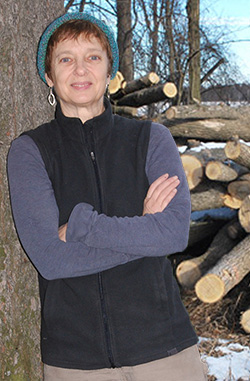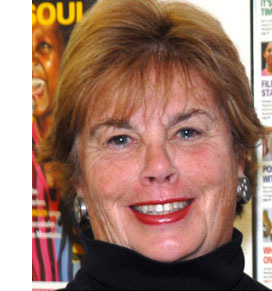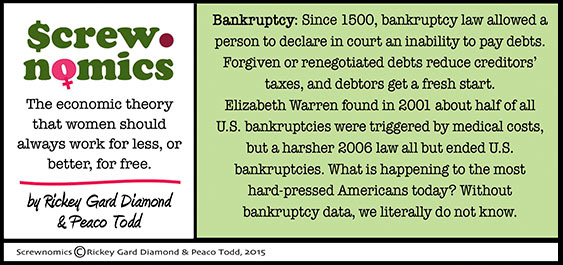Index - February/March, 2015 |
|
| Anatomy of a Nurse: The Heart and Backbone of Health Care |
| by Elayne Clift |

Vermont nurses (top) Eva Nunan, RN;
Felicia Robinson, CNM ; Mary Loney, RN, CHPN;
(bottom) Deb Clark, BSN; Amanda Young, RN |
“The best type of nursing girl is one who is tall, strong, and has a suppleness of movement. One who plays lawn-tennis, who can ride, skate and row, makes the best material. If she can dance, it is a great advantage, for graceful carriage is a thing to be cultivated. … If in addition to being well-formed she is favoured with good looks, it is all in her favour, for doctors readily recognize the influence of an attractive person in the management of refractory patients.”So claimed a British medical manual in the late 1890s.
The Journal of the American Medical Association added its two cents in 1902: “Nurses are often conceited and too unconscious of the due subordination [they] owe to the medical profession, of which she is sort of a useful parasite.”
Thankfully, nursing has come a long way since then. But even in the days when lack of respect and recognition were the norm, nurses were making a huge difference in health-care delivery, policy, ethics, and more. As Betty Rambur, professor of nursing and health policy at the University of Vermont Medical Center points out, “Florence Nightingale redesigned health care during the Crimean War in such a way that mortality declined dramatically.”
Continue Reading...
|
|
Barbara Fiske Calhoun:
Cartoonist, Free Spirit, and Cofounder of Quarry Hill Creative Center |
| by Cynthia Close |

Formal portrait taken of Barbara Fiske Calhoun,
January 8, 1946, the day she married Irving Fiske. |
In 1946, Isabelle “Barbara” Fiske Calhoun, then Barbara Hall Fiske, and her husband, Irving Fiske, bought 140 acres of farmland near Rochester, Vermont, with their wedding money. What started out as a family summer place eventually became known as the Quarry Hill Creative Center, which exists to this day.
I knew nothing about the center until reading an obituary in the Burlington Free Press for Calhoun, who died on April 28, 2014. The Free Press identified her as a ““hippie commune’ co-founder.” Having had a longtime interest in alternative communities, this immediately caught my attention, and I began to research what I learned was Vermont’s “oldest alternative living community and artists retreat.” Who was this woman and what had transpired on that property over the course of the last 68 years to earn such a reputation?
I discovered that the property is now in the hands of Isabelle (known as “Ladybelle”) McFarlin, Calhoun’s daughter. I called Ladybelle, asking to visit the center and interview her, and was pleasantly surprised by her friendly reception even though she didn’t know me. But Ladybelle warned me that visiting Quarry Hill a few days after a major snowstorm was not the best timing. She made it clear that the road to Quarry Hill might present some challenges.
Continue Reading...
|
|
| Human Trafficking: Sex Slavery in Vermont |
| by Cindy Ellen Hill |
 |
Slavery is far from dead—and Vermont is far from free of this pernicious evil. "It’s important that the public be aware that trafficking does occur and has occurred in Vermont,” says Andrea Van Liew, director of the Community Engagement and Training Department at the Vermont Center for Crime Victim Services.
The International Labour Organization estimates that three out of every 1,000 people on the planet have been trafficked—sold or compelled to engage in involuntary servitude in sex, farm, or factory trade—at some point in their lives and that approximately 20 million people worldwide are presently living in slavery. That’s about twice the number of Africans brought across the ocean in chains through what most Americans think of as the historical slave-trade era.
Continue Reading...
|
|
| Funding Special Education Benefits Us All |
| by Angela M. Timpone |
 |
Last fall, while I watched the Norwich University football team win 19–9 against Gallaudet University, I overheard words like “dumb,” “stupid,” and “retard” from NU spectators. These words weren’t comments on the Gallaudet players’ performance. The derogatory remarks referred to the players’ disabilities; Gallaudet students are deaf or hard of hearing.
Disability discrimination is often more socially acceptable than high-profile race discrimination and continues to plague our city streets, our universities, and our classrooms with little reflection or compassion. We chuckle or look away when remarks fly about a person’s disability.
Continue Reading...
|
|
| Vermonters Return to Wood Heat: It's Still the Way to Go |
| by Allison Teague |

Nancy Patch, forester for Franklin and
Grand Isle Counties and the first female
DFPR county forester in Vermont. |
“Chop your own wood and it will warm you twice.” Or if you are a logger, thrice: cutting the trees and getting the poles out of the woods; cutting, splitting, and stacking the cordwood; and burning it.
Many agree that heating with some form of wood, whether cordwood or processed wood in the form of pellets or wood chips, makes more sense now than ever before. In a world where storms knock out electricity, sometimes several times a year, heating with wood in Vermont is just common sense. As EPA standards and technology for wood-burning stoves and boilers have upgraded nearly every year, state officials say burning wood is an efficient and reliable heat source for Vermonters.
Wood-cutting lotteries for cordwood burners, state incentives for weatherization and switching to woody biomass (pellets and wood chips), and business incentives to explore some aspect of biomass production and distribution are reinforcing that choice for Vermonters.
Continue Reading...
|
|
| Curling |
| by Suzanne Gillis |

|
May our brooms be swift, May our Rocks strike true,
May our friendships grow, May our falls be few.
—author unknown
The Scots invented curling—along with golf, competitive bag piping, and single malt scotch. (Where else can you find tours designed just to drink your way through a country?)
Though curling is still practiced in Scotland, it is most firmly established in Canada. Ninety percent of the world’s one-million-plus curlers are Canadian, making curling a significant part of Canadian culture. Scottish immigrants, many of them members of the military and railroad workers, spread the game throughout Canada, starting in 1750.
The first curling club in Canada was the Royal Montreal Curling Club, established in 1807; in 1890 it became the first club in the world to admit women. It was also in 1890 that Canadian women held their first intercity Bonspiel (competitive event) between Montreal and Quebec. The Royal Caledonian CC in Perth, Scotland’s oldest curling club still in existence, admitted women in 1895.
Continue Reading...
|
|
Publisher's Message
Nurses: Whatever Would We Do Without Them? |
| by Suzanne Gillis |
|
Nearly everyone of a certain age has either been a patient, engaged with a nurse who became the voice and representative of a loved one, or performed nursing duties as a caretaker for a loved one. I count myself as one who has been or done all three.
In this issue, nurses are featured in our cover story, a rare focus on a profession that Americans, according to poll after poll, consider to be the most respected and trustworthy with the highest ethical standards. While doctors focus on pathology, diagnosis, and treatment options, nurses provide caretaking services that are vast, diverse, complex, and multilayered and require superior technical and personal skills, and they often must make on-the-spot decisions. Talk about multitasking under pressure.
Continue Reading...
|
 |
|
| Screwnomics: Bankruptcy |
| by Rickey Gard Diamond and Peaco Todd |

See the Latest toon in the Screwnomics series...
|
|







